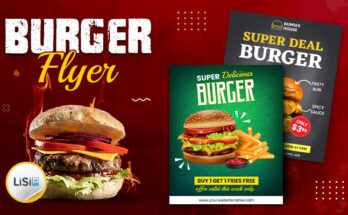Are you struggling to design an attractive and well-organized menu layout for your restaurant or café? If so, fret not! We have a solution that will make menu design a breeze.
In today’s fast-paced world, where customers are bombarded with countless options, a visually appealing menu can make a significant impact on their dining experience. A well-designed layout not only grabs attention but also helps customers navigate through the offerings effortlessly, leading to increased sales and customer satisfaction.
Say goodbye to the headache of manually positioning text and photos on your with the help of the Lisi menu maker Tool.
Okay, let’s get started with what you will learn here. We’ll explore the key features and benefits of this tool, along with step-by-step instructions on how to use it effectively. Additionally, we’ll provide you with expert tips and design principles to create visually appealing and user-friendly menu layouts.
Table of Content
- Importance of Menu Layout and Templates
- Types of Menu Layout
- Grid Menu Layout
- Tabbed Menu Layout
- Booklet Menu Layout
- Flyer-style Menu Layout
- Magazine-inspired Menu Layout
- Chalkboard Menu Layout
- Photographic Menu Layout
- Illustrative Menu Layout
- Typography-focused Menu Layout
- Collage Menu Layout
- Vintage-inspired Menu Layout
- List Menu Layout
- Landscape Menu Layout
- Classic Column Menu Layout
- Sectioned Menu Layout
- Best Practices for Effective Menu Layout
- Key Considerations for Choosing the Right Layout
- Read More Related Articles
- Menu Maker Apps for Mobile Phones
- Conclusion
- FAQ
Before we delve into the details of layouts and templates, it is essential to understand why matter and the importance of menu templates.
Importance of Menu Layout and Templates
A well-thought-out menu layout idea enhances user experience by providing easy navigation and ensuring efficient access to content or features. So, it helps users quickly find what they’re looking for, reducing frustration and improving engagement.
A well-designed layout can effectively showcase the restaurant’s brand identity and create a positive first impression.
“Intuitive menu layout is guiding users effortlessly.”
Let’s understand the types of menu layout ideas and well-designed templates, designers can elevate the usability and aesthetics of their projects, leading to enhanced user satisfaction and overall success.
Types of Menu Layout & Templates
Here are different types of menu layouts commonly used in restaurants:
Grid Menu Layout
The restaurant menu layout designs present a comprehensive and visually appealing selection of dishes in a structured and easy-to-navigate format. The restaurant divides the menu into clearly defined sections and organizes each item in a grid-like arrangement. The grid format also facilitates quick scanning and comparison of different options, making it convenient for customers to find their desired choices.
It is often used in applications, websites, and digital interfaces where there is a need to present a diverse range of choices or categories.
Tabbed Menu Layout
A tabbed layout is a user interface design that organizes content into multiple tabs, allowing users to switch between different sections of information or functionality within a single window or webpage.
Web applications, software interfaces, and mobile apps commonly use tabbed menus to present a hierarchical or categorized structure of information. Tabbed menus enable efficient multitasking and improve the overall user experience.
Booklet Menu Layout
A booklet layout typically consists of multiple pages arranged in sequential order, presenting a variety of food and beverage options.
The front cover showcases an enticing image or logo that represents the establishment’s identity, creating a strong first impression. Inside, the menu items are categorized into sections, such as appetizers, main courses, desserts, and beverages, with clear headings and corresponding descriptions.
The booklet layout strikes a balance between aesthetic appeal and functionality, providing an enjoyable and informative dining experience for customers.
Flyer-style Menu Layout
Our flyer-style layout showcases an enticing array of delectable dishes designed to tantalize your taste buds. The menu begins with a captivating title, adorned with elegant typography and eye-catching graphics that instantly capture your attention.
Whether you’re craving savory classics or exploring innovative flavors, our flyer-style layout is sure to leave a lasting impression and have you eagerly anticipating your next dining experience.
Magazine-inspired Menu Layout
The magazine-inspired layout brings a touch of elegance and sophistication to your dining experience. The menu is designed to resemble the pages of a glossy magazine, with sleek typography, vibrant colors, and high-quality images that showcase the mouthwatering dishes on offer.
As you peruse the menu, you’ll find intriguing stories and anecdotes about the inspiration behind each dish, making your dining experience not just a meal, but a captivating narrative that unfolds with every bite.
Chalkboard Menu Layout
The chalkboard layout features a rustic and charming design, with a black chalkboard as the background. The menu items are written in elegant, hand-drawn fonts using white or colored chalk, creating a visually appealing contrast.
The use of illustrations and decorative elements adds a whimsical touch, enhancing the overall aesthetic of the menu. It exudes a nostalgic and vintage vibe, reminiscent of old-school cafes and bistros.
Photographic Menu
A visually appealing photographic layout combines a well-structured design with high-quality images to entice and engage customers. The menu begins with a captivating cover photo that sets the tone and theme of the establishment followed by a clear and concise menu header that showcases the venue’s name or logo. The use of white space and consistent typography creates a clean and elegant look, while color schemes and font choices complement the overall aesthetic.
Illustrative Menu Layout
The menu is divided into distinct sections, starting with appetizers and salads, followed by main courses and side dishes. Each section is clearly labeled and accompanied by enticing descriptions of the dishes. The font is easy to read and the text is well-spaced, making it effortless for customers to navigate through the menu.
Tips for an Illustrative Menu Layout
- Use clear and concise headings for each menu section.
- Incorporate visually appealing typography for easy reading.
- Organize the menu into logical categories for quick navigation.
- Utilise high-quality, appetizing food photographs to enhance visual appeal.
- Consider using symbols or icons to indicate dietary preferences or special dishes.
- Highlight signature or popular dishes with a distinct design element.
- Provide clear pricing information next to each menu item.
- Consider a separate section for daily specials or seasonal offerings.
Typography-focused Menu
In designing a typography-focused layout, the primary objective is to create an aesthetically pleasing and user-friendly experience for the viewer. The menu should showcase an exquisite selection of fonts and typographic elements that not only enhance readability but also evoke a sense of visual harmony and sophistication.
Ultimately, a typography-focused layout aims to elevate the dining experience by presenting information in a visually engaging and sophisticated manner, where the art of typography takes center stage.
Collage Menu Layout
The collage layout features a dynamic arrangement of various images and text elements, creatively composed to provide an engaging and visually appealing experience for users. The menu typically consists of a combination of vibrant photos, illustrations, and typography, carefully arranged in a collage-style grid or overlapping fashion.
Vintage-inspired Menu Layout
Our vintage-inspired layout takes you on a nostalgic culinary journey, meticulously designed to transport you back to the golden era of gastronomy. With its elegant, hand-drawn illustrations and ornate typography, the menu exudes a timeless charm, reminiscent of old-world charm and sophistication.
List Menu Layout
The layout typically consists of a hierarchical structure that organizes the various options available in a clear and user-friendly manner. It often starts with a primary menu at the top or left side of the screen, containing main categories or sections. Each category can then expand into submenus or dropdown lists, revealing more specific options within that category.
Landscape Menu Layout
The landscape layout features a visually appealing and intuitive design that optimizes navigation for users. It utilizes a wide horizontal format, allowing for clear categorization and easy scanning of menu options.
The layout typically includes a prominent header at the top, displaying the brand or logo, followed by a horizontal menu bar below with clearly labeled sections or tabs. Each section expands when selected, revealing subcategories or additional menu options in a cascading manner.
Classic Column Layout
A classic column layout is a traditional design approach where the options are organized in a vertical format, typically arranged in a single column. This layout presents a clear and straightforward navigation system, allowing users to easily scan and locate the desired food items.
Sectioned Menu Layout
A sectioned layout refers to a design structure where the food list is divided into distinct sections or categories, allowing for easy navigation and organization of content. Each section typically represents a specific topic or area of interest, and within each section, related items or subcategories are grouped together.
You can check more types of restaurant menus
Best Practices for Effective Menu Layout
To create user-friendly and efficient menu layout ideas, it is essential to follow some best practices. Here are a few guidelines to consider:
- Use clear categories and headings to group menu items logically.
- Use brief, enticing descriptions that highlight key ingredients and flavors.
- Include high-quality images of select dishes to stimulate appetite and increase sales.
- Use legible fonts, appropriate font sizes, and contrasting colors to ensure easy reading.
- Keep your menu fresh by incorporating seasonal items and removing discontinued dishes.
- Clearly indicate vegetarian, vegan, gluten-free, or other dietary options to cater to a wider range of customers.
Key Considerations for Choosing the Right Layout
When choosing the right layout for a restaurant, there are several key considerations to keep in mind.
- Functionality: Ensure the layout meets the specific needs and purpose of the space.
- Space utilization: Optimise the use of available space to maximize efficiency and productivity.
- Flexibility: Choose a layout that allows for future adaptability and adjustments.
- Aesthetics: Consider the visual appeal and design elements that align with your desired ambiance.
- Accessibility: Ensure the layout is inclusive and provides easy access for everyone.
- Workflow efficiency: Design a layout that enhances workflow processes and minimizes unnecessary movement or bottlenecks.
If you found this article intriguing, you might also be fascinated by other blogs delving into innovative food list layout designs.
Read More Related Articles: Expand Your Knowledge of Menu Design
- Menu Design Ideas & Examples
- Types of Menus for Your Restaurants
- Restaurant Menu Design Ideas (Context Design Theme)
- How to Make a Menu: A Step-by-Step Guide for Effective Design
- Catering Menu Design Ideas & Examples
- Drink Menu Design Ideas & Example
- Cafe Menu Design Ideas & Examples
- Best Restaurant Marketing Apps in 2023
You can make your own menu utilizing mobile apps if you’re a mobile user.
Menu Maker Apps for Mobile Phones
To download the menu maker app, please click on the button below.
Menu Maker App for Android
Menu Maker App for iOS
Design and build your menu effortlessly using this menu maker app. Take your restaurant or business to the next level with visually appealing and user-friendly menus that leave a lasting impression on your customers.
Conclusion
By understanding the various types of menu layouts and their unique characteristics, you can make informed decisions when selecting the most suitable layout for your establishment. Remember to consider your target audience, ambiance, and cuisine style when making this choice. Incorporating best practices, such as maintaining visual appeal, utilizing appropriate typography, and organizing menu sections effectively, will contribute to a successful menu design.
So, go ahead and experiment with different menu layouts to create a captivating and memorable dining experience for your patrons.
FAQs
How does the menu layout affect customer experience?
This significant impact on customer experience as it directly influences how customers perceive and interact with the menu.
Which is the best menu layout?
The list menu layout is best for a casual dining restaurant.
What are some common mistakes to avoid in menu layout design?
Some common layout design mistakes to avoid: Overcrowding, Inconsistent typography, Poor organization, Inadequate descriptions, Neglecting visual appeal, Ignoring accessibility, Limited flexibility, Lack of branding, Failing to test and iterate
What are some accessibility considerations for menu design?
When designing menus, it’s important to consider accessibility by ensuring sufficient color contrast for readability and providing clear headings or sections for easy navigation.
Congratulations on taking this important step towards creating a menu that captivates and delights your patrons. Don’t wait any longer – get started on designing your menu today and watch your restaurant flourish! If you’re ready to take your menu design skills to the next level, explore our comprehensive guide on menu size to learn more. See you there.
To follow: Menu Size: Choosing the Perfect Portions






















